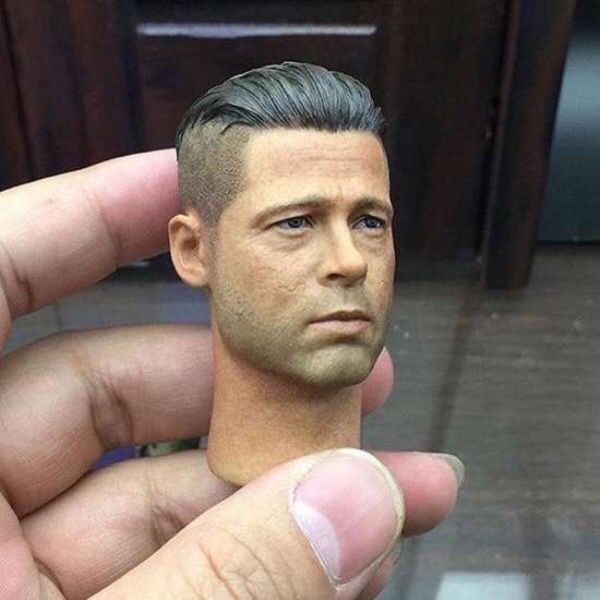
Found this photo on a website today... Unreal! Probably 1/9th scale? Not sure.
No idea who it was who is responsible for this work of art, but someone must know, right guys?








 Al
Al











Made by el1ev1en I believe, here's the instagram account: https://www.instagram.com/el1ev1en/





Packing up my brushes and paint, I will never be that good




Quoted TextPacking up my brushes and paint, I will never be that good
This "head" is VERY NICELY DONE!!!
Steve- DON'T pack up your brushes and paint! And YES, you CAN get that good! It took me about FOUR MONTHS OF STEADY FIGURE PAINTING before I reached the same level of work. I put all my other model-projects aside to concentrate on improving my skills, and I did nothing else but practice and try to improve my work every night that I wasn't working at my part-time job after school (or chasing girls!) before I achieved that level of work- I was 17 years old when I first started painting figures properly. If you're really serious about getting to that level, may I suggest the OSPREY "Bill Horan's Figure Painting Masterclass" book? (Sorry, I don't have the book in my hands, so the title above is in-exact) This book is a real "How To" manual, and is absolutely LOADED with color photos.
There are NINE to TWELVE STEPS in just painting a face, alone. With practice, after a while it just comes naturally. You'll come unto your own once you've mastered BLENDING your colors so that there is not a "too stark" of a contrast between shades. The key, if you're using oils with enamels, that is, is to wait a bit between colors, and then use just a tiny (almost dry) bit of turps (mineral spirits) on the brush that you're doing your blending with. I dip my brush in clean turps, and wipe the bristles on an old cotton T-shirt or a paper towel, leaving just a residue of turps on my brush. It's almost like "dry-brushing"...
Another thing to remember with the smaller scales, such as 1/35, 1/48, and 54mm, is NOT to use White for your eyeballs. This non-use of White will avoid that "pop-eyed" look that many modellers find themselves trapped into. In the daylight, even on cloudy days, people tend to squint, so the White isn't really necessary. A more convincing "eyeball" can be achieved by just using a Light Flesh color, and by "narrowing" the inside-horizontal dimension of the eyelids, after you've painted the iris and pupil of the eyeball. Mr. Horan goes into much more detail on this subject in his book, when explaining how to do the facial details realistically. There is a lot more to be learned than what I just mentioned above...
The key is PRACTICE!!!
PS- You'd be surprised how handy the proper colors of Weathering Powders are, which can be used to very good effect in creating different nuances of facial colors AND on hands and clothing, as well...





Quoted TextQuoted TextPacking up my brushes and paint, I will never be that good
This "head" is VERY NICELY DONE!!!
Steve- DON'T pack up your brushes and paint! And YES, you CAN get that good! It took me about FOUR MONTHS OF STEADY FIGURE PAINTING before I reached the same level of work. I put all my other model-projects aside to concentrate on improving my skills, and I did nothing else but practice and try to improve my work every night that I wasn't working at my part-time job after school (or chasing girls!) before I achieved that level of work- I was 17 years old when I first started painting figures properly. If you're really serious about getting to that level, may I suggest the OSPREY "Bill Horan's Figure Painting Masterclass" book? (Sorry, I don't have the book in my hands, so the title above is in-exact) This book is a real "How To" manual, and is absolutely LOADED with color photos.
There are NINE to TWELVE STEPS in just painting a face, alone. With practice, after a while it just comes naturally. You'll come unto your own once you've mastered BLENDING your colors so that there is not a "too stark" of a contrast between shades. The key, if you're using oils with enamels, that is, is to wait a bit between colors, and then use just a tiny (almost dry) bit of turps (mineral spirits) on the brush that you're doing your blending with. I dip my brush in clean turps, and wipe the bristles on an old cotton T-shirt or a paper towel, leaving just a residue of turps on my brush. It's almost like "dry-brushing"...
Another thing to remember with the smaller scales, such as 1/35, 1/48, and 54mm, is NOT to use White for your eyeballs. This non-use of White will avoid that "pop-eyed" look that many modellers find themselves trapped into. In the daylight, even on cloudy days, people tend to squint, so the White isn't really necessary. A more convincing "eyeball" can be achieved by just using a Light Flesh color, and by "narrowing" the inside-horizontal dimension of the eyelids, after you've painted the iris and pupil of the eyeball. Mr. Horan goes into much more detail on this subject in his book, when explaining how to do the facial details realistically. There is a lot more to be learned than what I just mentioned above...
The key is PRACTICE!!!
PS- You'd be surprised how handy the proper colors of Weathering Powders are, which can be used to very good effect in creating different nuances of facial colors AND on hands and clothing, as well...
Yeah! What HE said!
Perfect explanation.
I saw this modelers' stuff on FB for a while now and he gets these results a lot! With the roper blocking and background there is no way to tell this apart from reality.
J




 |